Timing and Synchronization has become a key requirement for successful deployments of 4G/5G networks. It provides a network-based framework for distributing time, frequency and phase from a clock source over a packet-based network. A clock is a network node participating in this distribution. All network elements in time critical deployments need to be synchronized to a universal source with a clock synchronization accuracy in nanoseconds.
For successful network deployments, telecom operators are increasingly relying on parameters such as low latency, faster speeds, frequency range, device density, phase alignment and redundancy. Distribution of timing clock plays a crucial role in achieving these parameters. A high-level look at the evolving network parameters is indicative of the growing demands that are placed on timing and synchronization in a telecom network.

Timing Characteristics for Applications
Applications running on 4G/5G networks have an inherent requirement for synchronization amongst the participating network elements. In addition to telecom networks, other time critical applications relying on accurate clock synchronization include stock markets, 5G based machine-to-machine communication and large manufacturing plants using IoT and Edge data centers.
The timing characteristics of a Telecom Boundary Clock (T-BC) and Telecom Slave Clock (T-SC) as recommended by ITU-T G.8273.2 for applications are as follows:
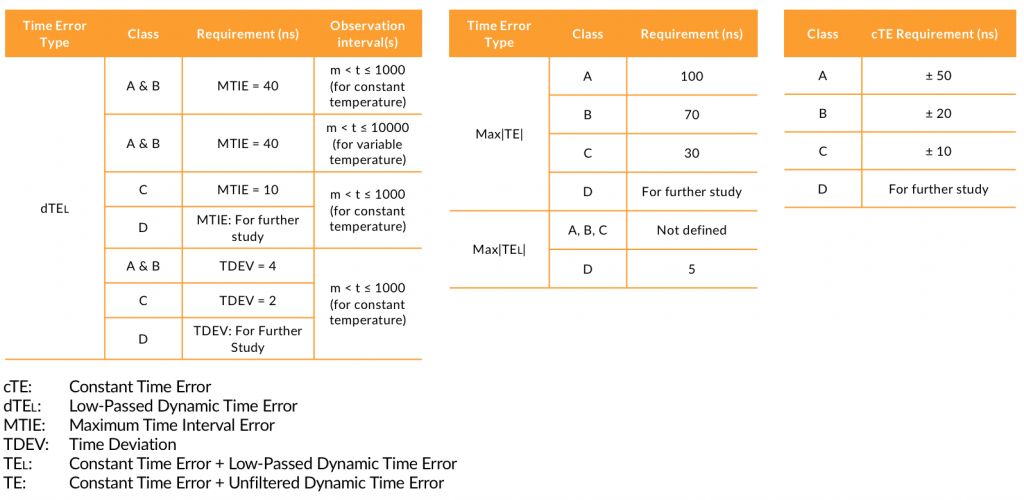
As can be seen above, T-BC and T-SC clocks are determined by strict time-error parameters.
IP Infusion has been able to deliver a market-leading clock accuracy with a Constant Time Error (cTE) of ± 10ns. The robustness of our disaggregated solution has been validated against leading Timing Test Solutions and meets the parameters specified for Class C T-BC/T-SC.
Understanding Timing & Synchronization in an Access Network
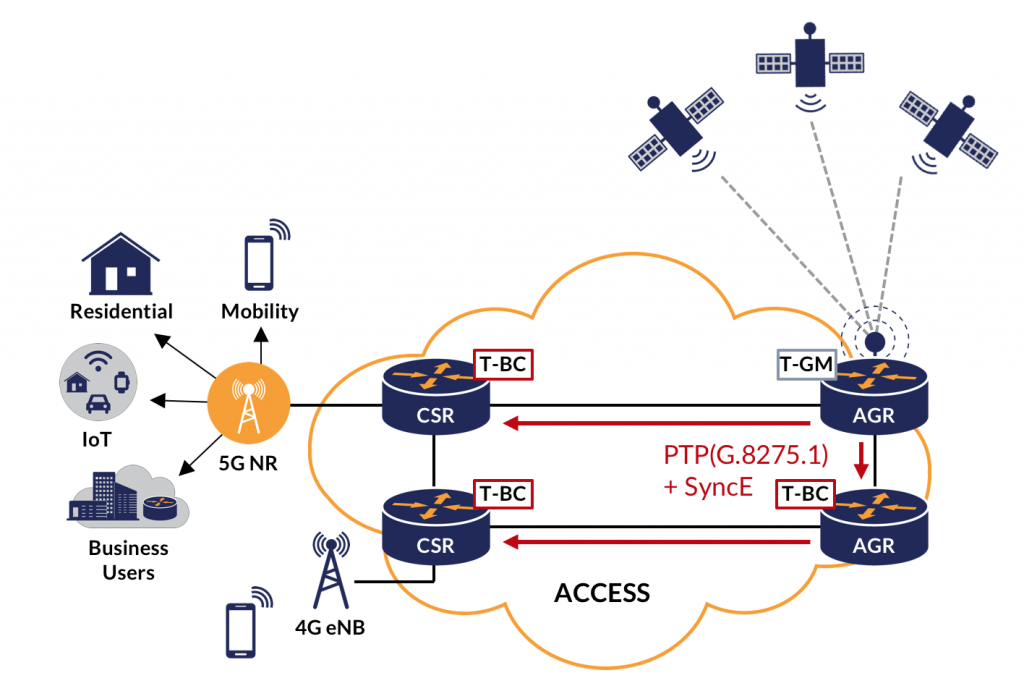
In an Access network, an Aggregation Router (AGR) or a Cell Site Router (CSR) would receive the clock synchronization from a primary source. In the above diagram the primary source for clock reference is shown as a satellite (via GNSS interface). However, alternately a high accuracy clock source can be used as a primary clock reference. The synchronized node then behaves as a grand-master clock (T-GM) and provides the reference to the remaining nodes in the network, such as the CSR (T-BC) and the base stations (T-SC).
How OcNOS is Delivering Timing & Synchronization?
IP Infusion’s OcNOS networking operating system addresses these network requirements by using IEEE 1588v2 Precision Time Protocol (PTP) and Synchronous Ethernet (SyncE). Our solution is compliant with the timing requirements for the Disaggregated Cell Site Gateway (DCSG), per Telecom Infra Project (TIP).
In order to meet the stringent timing requirements of 4G and 5G networks it is required that the Timing Solution supports extensive clock synchronization capabilities. This involves identifying a primary reference source and providing its clock as reference to all elements in the network.
For the network element clocks to be synchronized, it is required that these clocks are driven from a common source. Primarily, the time, frequency and phase need to be referenced and locked to a common source.
Synchronous Ethernet (SyncE) is the preferred solution to synchronize frequency over Ethernet-based networks. Each networking device with an embedded hardware clock is referred to as an Ethernet Equipment Clock (EEC) and is driven by an oscillator. This oscillator is responsible for adding the frequency reference on each outgoing ethernet frame. It is required that each element in the network supports SyncE for the chain to be synchronized.
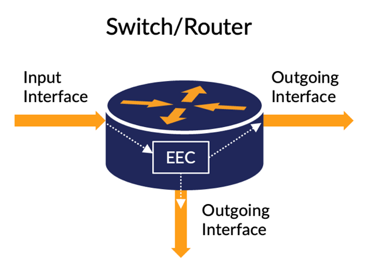
Precision Time Protocol (PTP) is used for phase and time synchronization in a network. PTP has various profiles which allow for clock synchronization parameters to be specified.
A node supporting PTP can work in modes such as T-GM (Grand Master Clock), T-BC (Boundary Clock),T-TC (Transparent Clock) and T-TSC (Time Slave Clock).
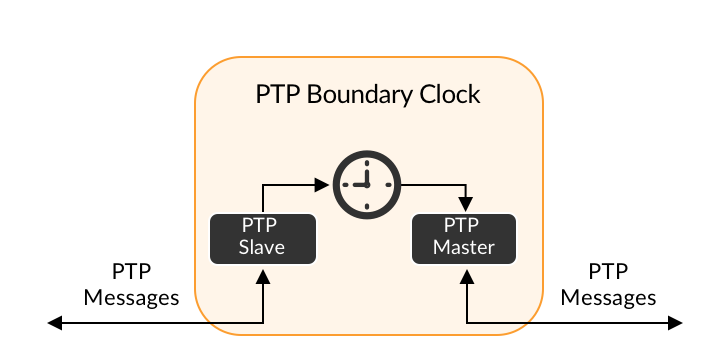
PTP messages are transmitted by the T-GM. The T-BC has Master and Slave Clock components. The Slave component terminates the PTP frames from the T-GM and synchronizes the local clock to it. This local clock drives the PTP Master component of the T-BC which in-turn sends messages downstream.
For a T-TC, when the PTP message arrives on a switch/router, the hardware timestamps it. It is then passed to the switching/routing functions. When the frame is exiting the node, the hardware again timestamps it. The departure and arrival timestamps are extracted and used to update the correction field in the subsequent messages.
A Slave clock (T-SC) synchronizes with the master or grandmaster clock but does not act as a source of timing.
PTP can also be used for frequency synchronization in the network, however, SyncE is the preferred protocol for it.
Timing and Synchronization flow
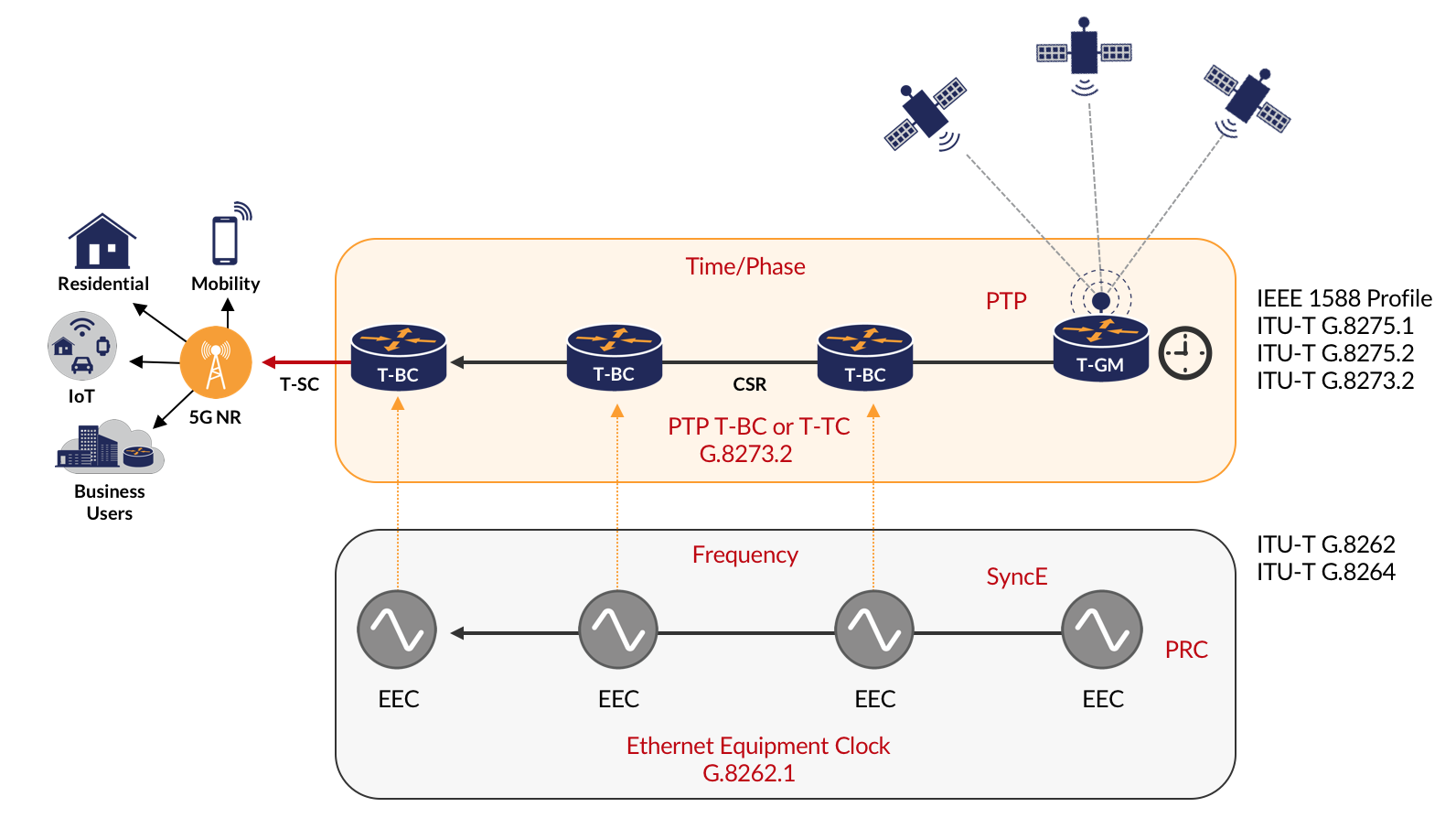
Here, the node (denoted as T-GM) receives the clock reference on the GNSS interface via the satellite. Once the clock is locked to the satellite via GPS, it can act as the source and provide the clock reference to other network elements. OcNOS has the additional capability of synchronizing with another T-GM thus enabling solutions that do not have an external GNSS hardware interface.
For PTP, this is then referred to as the Grand Master Clock (T-GM). Each subsequent node which acts as a Boundary Clock (T-BC), receives the PTP packets on one interface, locks the Phase/Time to that reference (slave mode) and generates the relevant PTP messages out of the other interfaces (master mode).
For frequency, the source is the Primary Reference Clock (PRC). The clock is considered as the Ethernet Equipment Clock (EEC). SyncE control plane algorithm is used to identify the input interface to drive the clock. Once the interface is identified and the clock is locked, the frequency is relayed as all outgoing frames from output interfaces reference the same clock source.
IP Infusion’s OcNOS has advance timing capability with extensive support for the following PTP standards –
- IEEE 1588 Default Profile (Annex J)
- ITU-T G.8275.1
- ITU-T G.8275.2
- ITU-T G.8265.1
- ITU-T G.8273.2
- ITU-T G.8273.3
- ITU-T G.8273.4
- ITU-T G.8272
Our SyncE support is compliant with the following standards –
- ITU-T G.8262
- ITU-T G.8262.1
- ITU-T G.8264
The OcNOS based DCSG solutions have additional dedicated timing interfaces such as GNSS, 10 MHz, 1PPS, BITS and ToD interfaces to provide comprehensive timing support. This helps the clock lock to the satellite source (via GNSS) as well as provide interfaces for testing and verifications in the field (1PPS in/out). The 10MHz and BITS interfaces provide additional flexibility by extending the clock reference for easier integration with SDH/SONET and other TDM based networks.
Conclusion
The OcNOS Timing and Synchronization capabilities have been successfully deployed at multiple customer locations and is now widely regarding as a leading NOS for Timing and Synchronization solutions.
We remain committed to delivering the latest developments in Timing and Synchronization to our customers in an efficient and scalable manner.
If you’d like to build your network with our state-of-the-art Timing and Synchronization support, reach out to us at ipisales@ipinfusion.com.
By Rishi Narain

